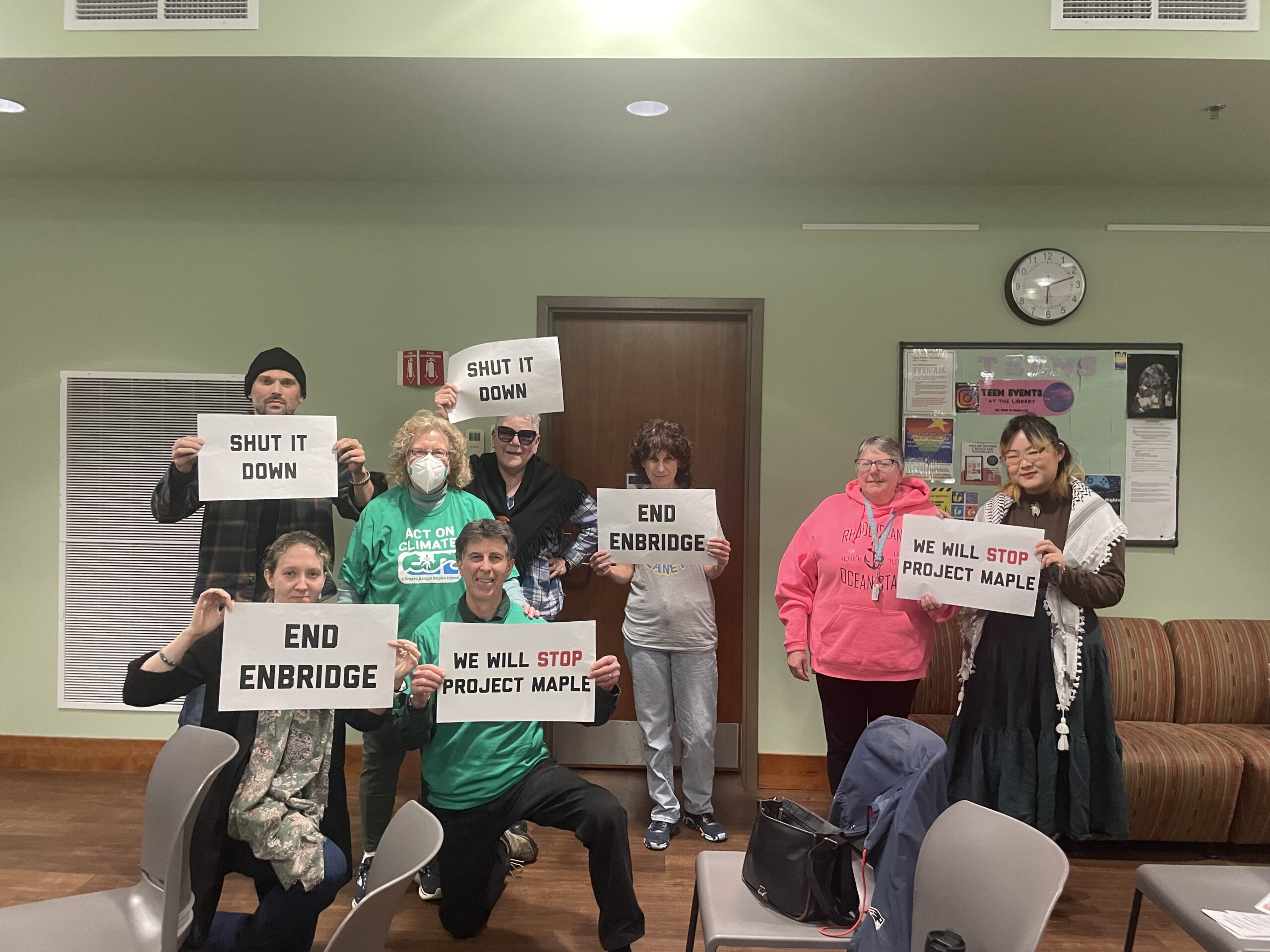DEM Wildlife Expert Testifies Proposed Power Plant Presents ‘Unacceptable Harm’
March 28, 2019
WARWICK, R.I. — The Energy Facility Siting Board (EFSB) may finally have justification for denying the proposed Burrillville power plant.
The three-member council has a trio of questions it must weigh as it evaluates the application for the Clear River Energy Center: Is the power plant needed to meet the energy needs of the state or region? Is it cost justified? Does It cause unacceptable harm to the environment?
Jason Osenkowski, deputy chief of wildlife at the Rhode Island Department of Environmental Management (DEM), recently testified regarding the third question.
At the March 26 hearing, Osenkowski was asked by EFSB chairwoman Margaret Curran if he would characterize the fossil fuel power plant as causing unacceptable harm to the environment.
After a long pause, Osenkowski replied, “I would view it as unacceptable harm because I believe that avoidance is an option. … And the detriment to the continuity of that habitat and the species that rely on that continuity to me is avoidable and as a result I think it’s unacceptable.”
Curran also asked about another potentially threatening issue for the $1 billion project: the assertion made by Osenkowski and ecologist Anthony Zemba last week that Invenergy’s wildlife survey of the 67-acre site is flawed. Osenkowski said that although the 10-week survey used by Invenergy is standard practice, the tracking and trapping methods used to identify wildlife would need to be in place for months and even years to collect complete data.
“It would be my recommendation that it would be multi-year,” Osenkowski said. “If you are looking to be comprehensive then you would need to have a multi-year survey.”
EFSB member Janet Coit, Osenkowski’s boss as director of DEM, noted that there are no regulations that require multi-year habitat studies.
“Unfortunately, that is correct,” Osenkowski said.
Osenkowski noted that budget cuts at DEM ended programs that collect state wildlife data. Information from those programs would inform wildlife surveys, he said. He further acknowledged that there are no regulations to halt a development if species are found that are considered threatened or endangered by the state. Only the presence of federally designated or threatened species jeopardize an application.
“I would change that in a heartbeat,” Osenkowski said.
Elizabeth Noonan, an attorney for the developer, Chicago-based Invenergy, noted that Osenkowski’s conclusion that the Clear River Energy Center poses unacceptable harm isn’t in DEM’s advisory opinion nor in its supplemental report. Osenkowski responded by remarking that both reports weren’t directly addressing the issue of unacceptable harm but the more narrow questions related to permits.
In its first report, DEM concluded that the agency needed more biodiversity data from the site and construction plans from Invenergy. DEM stated the site is worth preserving because it’s adjacent to state conservation land and keeping it undeveloped would reduce fragmentation of the larger forest ecosystem.
DEM is reviewing permits for air pollution and wetland destruction. DEM’s advisory opinion concluded that a failure to receive the permits “represents unacceptable harm to the environment.”
The issue, however, is complicated by DEM’s supplemental report that states if the permits are issued “it is a formal declaration that the proposed facility has met the standards and criteria for acceptable harm to the environment as established in state and federal laws and regulations.”
At the March 21 EFSB hearing, Burrillville’s attorney, Michael McElroy, sought to make a distinction between the environmental impact related to the permits and impacts caused by the project overall.
During questioning of Terrence Gray, DEM’s associate director, McElroy got clarity on the separate perspectives of unacceptable harm, when Gray confirmed that the project’s impact on wildlife only applies to the scope of the permits not to the impact of the entire project.
The EFSB will not likely act on Osenkowski’s statement soon. The final hearings continue March 28 and are expected to run through April. After that, all parties will write and submit closing statements. The board will then discuss the application in open meeting and render a decision within 60 days. Additional information on the procedural process is online.
Categories
Join the Discussion
View CommentsRecent Comments
Leave a Reply
Related Stories
Your support keeps our reporters on the environmental beat.
Reader support is at the core of our nonprofit news model. Together, we can keep the environment in the headlines.
We use cookies to improve your experience and deliver personalized content. View Cookie Settings




Osenkowski testified to the following point that has HUGE implications for the exploding controversy of solar project siting in high-value forest land along our western forests along the RI-Ct border:
"He further acknowledged that there are no regulations to halt a development if species are found that are considered threatened or endangered by the state. Only the presence of federally designated or threatened species jeopardize an application."
This pertains in spades to all present solar siting legislation. All solar projects, so far, are and would be under proposed new regulation, reviewed for approval only by local authorities—local Planning and Zoning Boards. DEM has or will have no role except one pertaining to "Jurisdictional Wetlands." If you have a question of "State-listed" species being present that do not dwell in wetlands, they have no statutory standing. The local solar approval process has no obligation to consider their potential presence as a hinderance to project approval, just as Osenkowski admits regarding DEM’s lack of authority over "State-listed and "Species of Greatest Conservation Need" that dwell in the "Non-jurisdictional Uplands" portion of the power plant site—though, thank God, in the Invenergy question, the EFSB itself does have the authority to rule in their regard.
But local Planning and Zoning boards do not have that authority in solar cases presently, or in any of the bills yet proposed to improve the solar siting process. Our western forests will continue to be chewed up regardless of their degree of environmental value.
Once again, for the environmental community, the Invenergy power plant proposal in Burrillville is a huge big deal.
"He further acknowledged that there are no regulations to halt a development if species are found that are considered threatened or endangered by the state. Only the presence of federally designated or threatened species jeopardize an application."
But where else might we site this much-needed power plant?
Brayton Point perhaps?
Bill Eccleston makes an excellent point regarding the lack of any jurisdiction by DEM for the protection of upland forests and habitat to effectively manage solar development. Grow Smart RI has proposed an amendment to the pending solar siting bills in the legislature. Our amendment would preclude State renewable energy programs from providing any economic incentive to encourage the development of ground mounted solar in areas of environmental concern such as forested tracts of 250 acres and greater, high value and high vulnerability habitat, and RI designated rare and endangered species. This proposed amendment strikes a balance by protecting RI’s most important natural areas and allows enough land to support future solar development. RI doesn’t need to sacrifice our most important natural areas for solar development. For a copy of my testimony on this bill:
https://bit.ly/2YK3Bpn
Scott Millar
Grow Smart RI
I understand the concerns in Burrillville. I applaud those who also have concerns about the solar farms doing just as much damage to wildlife and habitat, and having to practically destroy far more woodland for far less energy. Solar is in today’s "protected green class," and fossil fuels are in the oh-so-hated "polluting" class these days. Sadly, it seems to be all about whose "team" you’re on. I’m glad at least this inconsistent insanity (in my view) is being exposed. There is a middle ground. Let’s work harder at it.
Hi Art, I hope all is well. What makes you say this is a "much needed" power plant? The facts as I see them say otherwise. The wholesale price paid to power generation facilities have dropped 79% since 2015. This particular applicant lost their contract to produce power, and there were power plants waiting to snatch up that obligation. In the foreseeable future, this new, additional power plant seems to be anything but "much needed."
Tom Ward, you haven’t been following the story hear. This testimony has nothing to do with pollution and fossil fuel and what’s to be done to stifle the increasing carbon content of the atmosphere. There is no need to argue these questions in this case.
The story of the Burrillville power plant is the story of its wildly inappropriate location. Since when do we suspend a generation’s worth of land-use regulation to build a major industrial facility on the border of a complex of 6 state forests and a major Boy Scout reservation, altogether totaling over 26 square miles, which is so rich in critical habitat and threatened species that when the picayune 67 acres slice of this forest that the power plant and its clear-cut power line right of way would occupy, the biological survey done by Invenergy’s own environmental consultants found 17 "State-listed" species—the highest category of threat—and 47 (which included 15 of the State-listed) "Species of Greatest Conservation Need!"
This is where it’s ok, in your world, to build major industrial facilities? This one, if approved, being the most expensive construction project in the entire history of the state of Rhode Island?
Seriously, you would repeal the state’s Comprehensive Planning Act, too; you would repeal the individual land-use plans of each community in the state? And you think there’s no need for interstate collaboration to protect places like this, where scienftically credentialed experts in the fields of wildlife biology and ecology, such as Mr. Osenkowski, testify not merely to the need for RI, CT and MA to collaborate to protect this forest, but in fact DO collaborate?
You rail—justly, most of the time—against the political chicanery that seems to be the lifeblood of this state, and yet you don’t recognize, just computing a few of the facts stated above, that the siting of this plant is a classic bete noire of that genre?